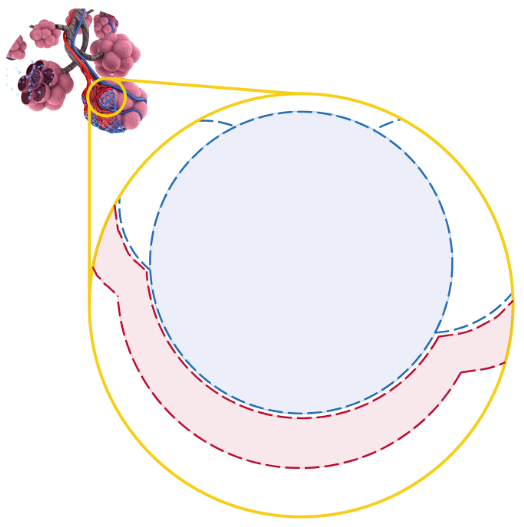Understanding Gaseous Exchange: A Guide for Teachers
The topic of gaseous exchange exists in a huge range of PE qualifications. From GCSE to A-level to BTEC to VCERT to International Baccalaureate. Yet, are we, the PE teaching sector, really sure that we deliver this topic well? Do we associate our teaching with how students learn gaseous exchange in biology and are we confident –I meanly truly confident– that we intuitively understand the process of exchange above being able to simply teach what is expected in an exam?
My sense is that the PE teaching sector would benefit from some clarifications around gaseous exchange. Therefore, I am writing this post to support the sector in raising the standard of the teaching of this topic.
Shall we start at the beginning? What is gaseous exchange and why does it matter? Well, human beings are multicellular organisms and, like any other multicellular organism, need to utilise transport networks to deliver resources to every cell in the body. Oxygen needs to be extracted from the outside air and delivered to every cell so that respiration can occur. In extreme cases, a lack of oxygen delivery can kill a person. In terms of the study of PE, efficient oxygen delivery directly influences the efficiency of exercise bouts. Carbon dioxide (produced in the cells during aerobic respiration) needs to be transported to the lungs and expelled to the outside air. This is what we call gaseous exchange.
But I want to take the intuition further. In the paragraph above, I used the terms “extract” and “expel”. If we ask, “From where is gas extracted, and to where is it expelled?” this can give us a deeper grasp of intuition. Take a look below:
|
Site |
Gas |
From |
To |
|
At the lung |
Oxygen |
Net✽ movement from the outside air… |
…to the blood. |
|
Carbon dioxide |
Net✽ movement from the blood… |
…to the outside air. |
|
|
At the tissue (muscle) |
Oxygen |
Net✽ movement from the blood… |
…to the tissue (muscle). |
|
Carbon dioxide |
Net✽ movement from the tissue (muscle)… |
…to the blood. |
✽Net refers to overall movement. Gases move in both directions and “net” indicates the direction of travel for the majority of gas molecules in each case.
And this brings me to my first major point: gaseous exchange occurs when gases move from outside the body to inside and vice versa. But, in order to understand this, we need to determine what inside and outside of the body means. So, I would like you to ponder the following. In each case, is the description of the inside or the outside of the human body?
- The inside of an alveolus in the lung
- The blood stream
- The inside of the small intestine
- The inside of a muscle cell
- The inside of the trachea
So, what do you think? Let me ask you a question:

Inside of the body:
- The blood stream
- The inside of a muscle cell
Outside of the body:
- The inside of an alveolus in the lung
- The inside of the small intestine
- The inside of the trachea
When we recognise this fact, it helps us as teachers to place the intuition of gaseous exchange: It occurs when a gas crosses a membrane. Air passing down the trachea, the remainder of the respiratory network and arriving in an alveolus has not crossed a membrane and is, therefore, technically outside of the body. Likewise (although not specifically relating to the exchange of gases), food which enters the mouth, follows the digestive system including the stomach and arrives in the small intestine in the form of chyme, is still technically outside the body. It only gets “inside” when it is small enough to be passed through a membrane in the form of glucose and amino acids, say.
So, fact 1 is now established:
Now we can begin to think about how gases cross membranes. It doesn’t seem that obvious until it’s broken down in our minds. Let’s use the membrane(s) between an alveolus and the blood that passes by via a capillary as our example:

The blue area represents the inside of the alveolus. Remember, this is “outside” the body still. The red area represents the capillary. Remember, this is “inside” the body because the gas has to cross a membrane(s).
The dashed lines represent the membranes. As you can see, there are two membranes in the image: the blue one is the alveolar membrane and the red one is the capillary membrane. Both are formed by epithelial or “lining” cells. They are dashed not because they look like this in real life but, rather, to represent that they are partially permeable. Both the alveolar and capillary membranes are partially permeable, which means that objects that are small enough and are moving, can pass through the membrane.
So, now we have fact 2:
It is reasonable to ask: why do only gas molecules pass through the membrane? Why doesn’t a red blood cell pass through too? The answer, thankfully, is super simple: gas molecules such as molecular oxygen (02) and carbon dioxide (CO2) are teensy-weensy in comparison to cells. Therefore, they can pass through the partially permeable membrane(s) and move from one environment to another without larger objects doing the same.
So, now we have fact 3:
But, why do gas molecules move? Why don’t they just stay where they are rather than crossing a membrane? Is it momentum? Do they “want to” cross the membrane? Well, no. Reality is actually much, much simpler than this. Kinetic theory tells us that the gas molecules are moving randomly because they are energised. They are bouncing around randomly and, due to this and for no other reason, some of them randomly bounce through the partially permeable membrane(s). That’s it. I mean, that really is it. The energy that the gas molecules carry causes them to bounce about. There is nothing more to it than this.
Now we have fact 4:
So, we have teensy-weensy gas molecules bouncing about in the vicinity of a partially permeable membrane and some of them pass through. So why do we tend to think that gases move in one direction only? How do the O2s know to go from the alveolus into the blood rather than the opposite and how do CO2s know to go from the blood into the alveolus rather than the opposite? Well, they don’t know anything, of course and, in fact, gases do indeed travel in both directions. But there tend to be different concentrations of each gas on each side of the membrane. In other words, there is more O2 bouncing about in the alveolus than there is in the blood and there is more CO2 bouncing about in the blood than in the alveolus. This, combined with the random movement of the gas molecules, causes an overall (net) movement of O2s from the high concentration in the alveolus into the blood, which has low concentration, as well as an overall (net) movement of CO2s from the high concentration in the blood to the low concentration in the alveolus.
So, now we have fact 5:
At this point, and assuming you’ve travelled the journey of this post with me so far, I want to ask a question about the intuition of this topic:

So , now we have fact 6:
Now that we have all of these facts, it is possible to return to what most PE teachers teach to students and recognise how obvious these concepts are because we have the intuition of the topic.
Consider the following in relation to what we have covered. Do these statements make sense given what we have learned?
- Gases move from high concentration to low concentration.
- Gases move down the concentration gradient.
- There is a net movement of oxygen from the alveolus to the blood.
I’m optimistic that the answer is yes, in each case. Why? Because we intuitively understand this topic. We are now able to truly teach it and to educate whilst doing so?
Thank you for reading the post. It was a wordy one! If you got to the end, fair play to you.
Have a lovely day.
James
%20Text%20(Violet).png)


